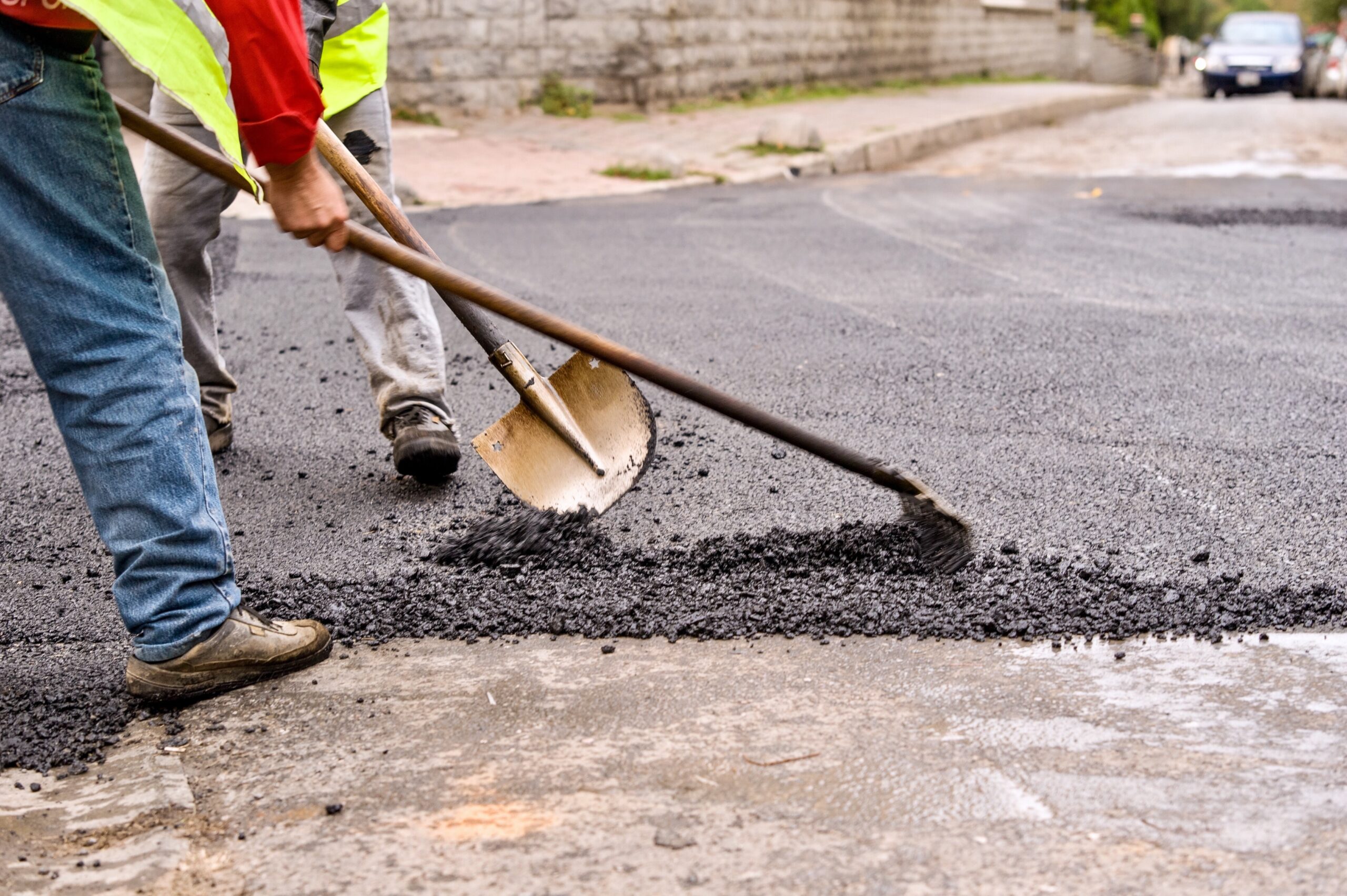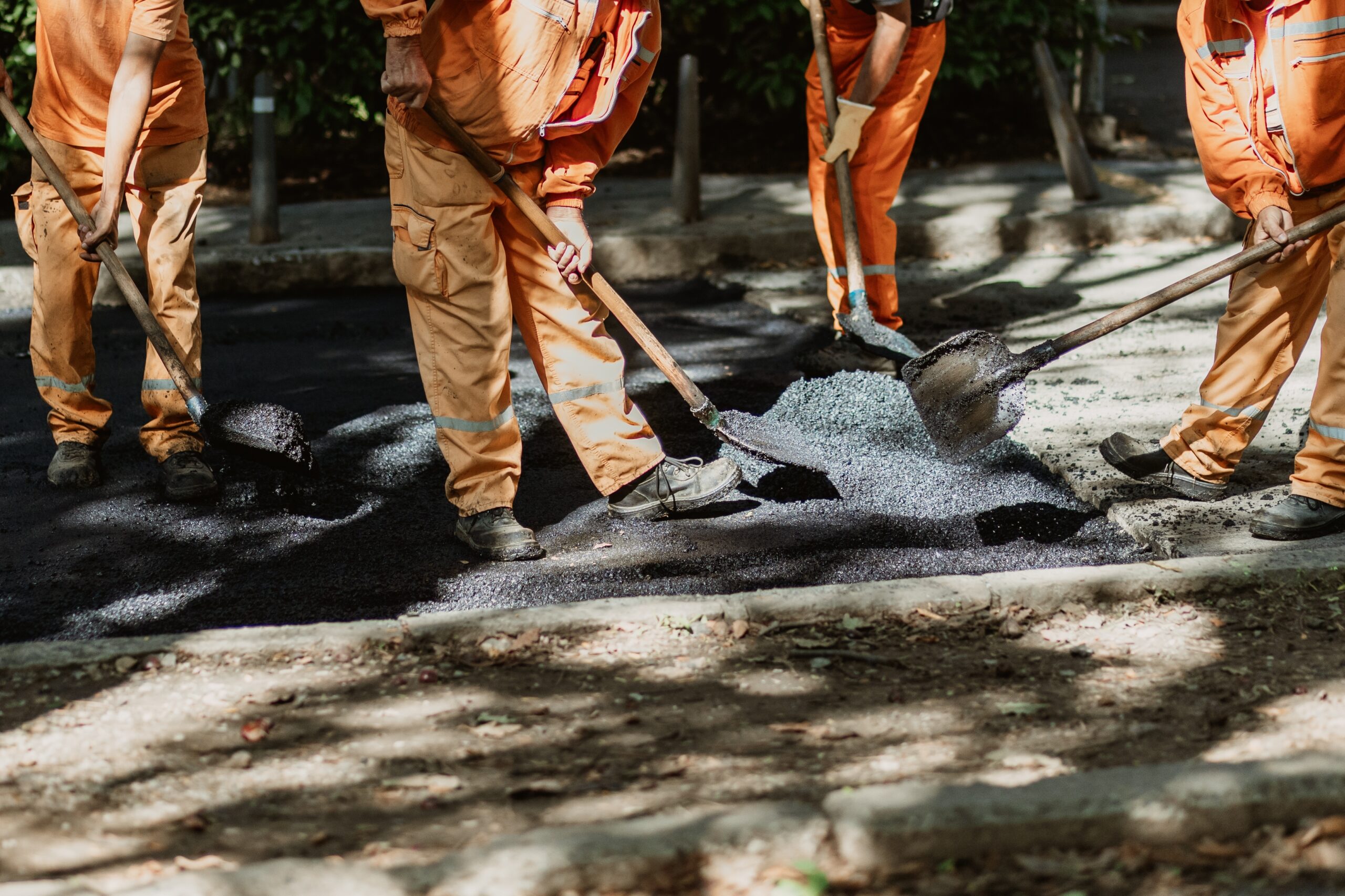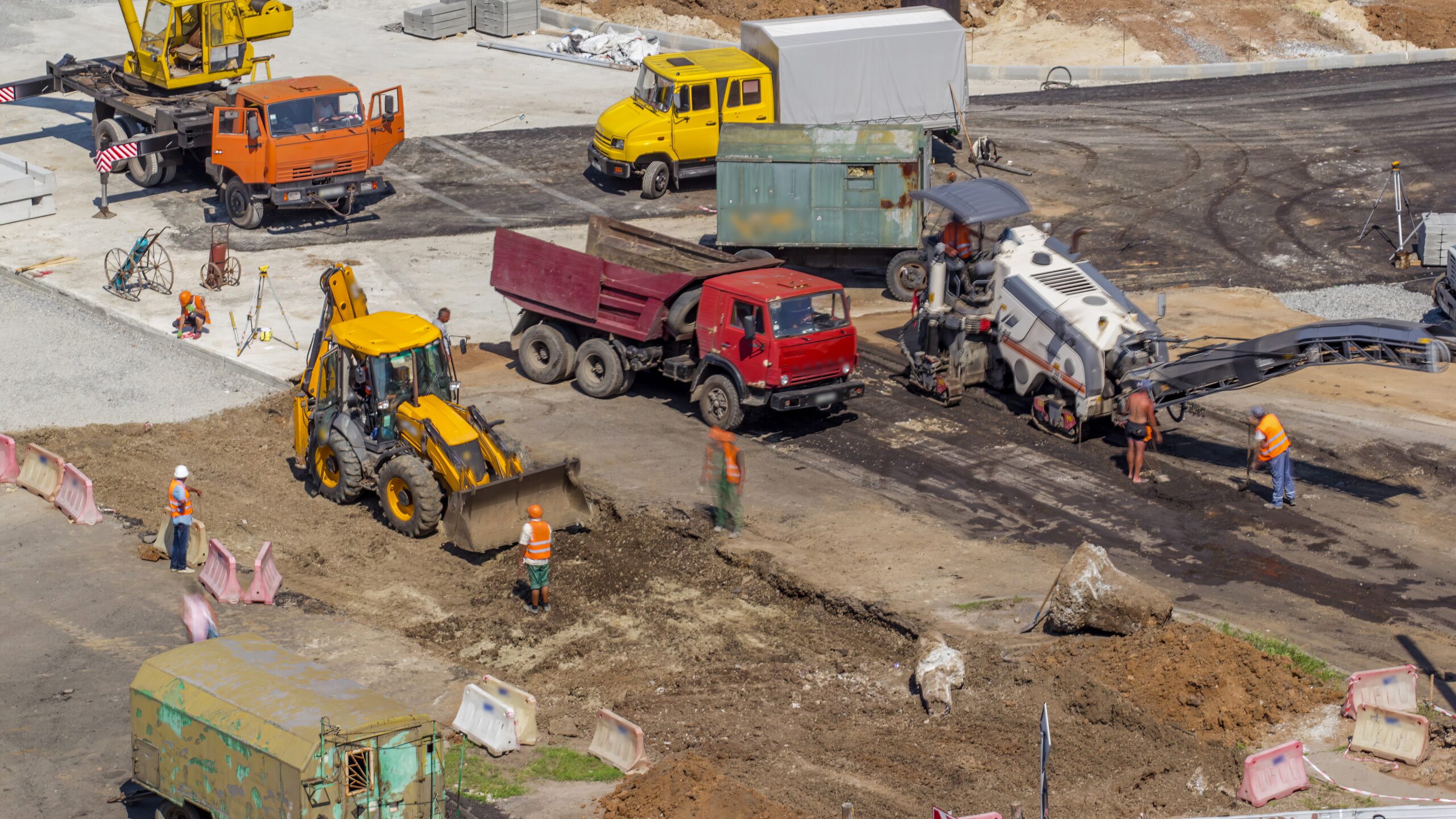When it comes to maintaining a professional image and ensuring the safety of your customers and employees, the condition of your business’s paved surfaces plays a crucial role. A well-maintained parking lot, driveway, or sidewalk not only enhances curb appeal but also reflects your commitment to quality and attention to detail.
In today’s competitive market, first impressions are more important than ever. A deteriorating parking lot or cracked sidewalk not only deters potential customers but also creates dangerous slip hazards.
In fact, the U.S. Bureau of Labor Statistics reported 885 worker deaths in 2023 from falls, slips, and trips, making pavement upkeep not only a branding issue but also a safety and liability priority.

This guide will walk you through everything you need to know, from spotting the first signs of trouble to understanding the long-term value of hiring a professional paving contractor.
First Impressions Matter: Your Pavement Speaks for You
The moment a customer, client, or employee arrives at your property, their experience begins. A smooth, well-marked, and clean parking area conveys professionalism and attention to detail, while a cracked and crumbling surface can suggest neglect. This initial perception can influence their confidence in your business before they even walk through the door.That’s why investing in parking lot maintenance that saves money is also an investment in customer trust and your brand reputation.
A study in the Journal of Real Estate Finance and Economics found that curb appeal, yours and that of neighboring properties, can account for up to 7% of a home’s sale price, increasing even further in weaker housing markets.
Branding Through Curb Appeal
Think of your commercial property’s exterior as part of your marketing. A freshly paved and striped parking lot creates a positive, inviting atmosphere. It signals that you care about your property and, by extension, your customers.
This enhanced curb appeal can differentiate you from competitors and reinforce a brand image of quality and reliability. The surface evenness, clear markings for pedestrian flow, and overall clean appearance contribute to a business image that attracts and retains clientele.
Slip and Fall Prevention
One of the most significant responsibilities of a business owner is ensuring a safe environment. Potholes, cracks, and uneven surfaces are more than just eyesores; they are serious trip hazards. A single slip-and-fall incident can lead to costly lawsuits, increased insurance premiums, and damage to your reputation.
Professional paving contractors ensure a level surface, proper drainage to prevent ice patches in winter, and clear, safe pathways for pedestrian safety. Investing in pavement maintenance is a direct investment in reducing your business’s liability.
ADA Compliance
The Americans with Disabilities Act (ADA) has specific requirements for parking lots and pedestrian routes to ensure they are accessible to everyone.
According to the 2010 ADA Standards for Accessible Design and the U.S. Access Board, businesses must provide a set number of accessible parking spaces based on lot size, with each space and access aisle meeting exact width and slope guidelines. Ramps cannot exceed a 1:12 slope ratio, and parking spaces and access aisles must not be steeper than 1:48 (≈2.08%).
A non-compliant property can face significant fines and legal action. A qualified paving contractor understands these intricate ADA standards and can ensure your property meets slope requirements, has proper safety signage, and provides safe, compliant access for all patrons.
When Is It Time to Call a Pro? Spotting the Red Flags
Pavement doesn’t fail overnight. It deteriorates over time, and catching the warning signs early can save you from more extensive and expensive repairs down the road. Knowing what to look for allows you to be proactive rather than reactive when it comes to your property’s pavement.
Surface Distress and Cracking
Small, isolated cracks can often be sealed as part of regular maintenance. However, when you see widespread, interconnected cracks, often called “alligator” or “spiderweb” cracks, it’s a critical red flag.
According to the Federal Highway Administration’s LTPP Distress Identification Manual, this crack pattern is classified as fatigue cracking. This load-associated distress typically indicates the sub-base or lower layers are failing. Once water penetrates the foundation, it weakens the pavement structure and accelerates severe damage. Simply paving over these cracks is only a temporary fix that will fail quickly.
Potholes and Uneven Surfaces
Potholes begin as small cracks that allow water to seep into the base layers. As vehicles drive over these weakened spots, the load stress causes the surface to break apart, creating a hole.
According to the Federal Highway Administration, potholes typically form from a combination of moisture infiltration, freeze–thaw cycles, traffic loading, and weak underlying support. An uneven or warped surface, known as rutting, is another sign that the foundation can no longer support the weight of traffic. Both potholes and rutting are significant trip hazards and can damage vehicles, making professional repair essential.
Drainage Problems and Water Pooling
If you notice standing water or water pooling on your pavement long after it rains, you have a drainage issue. This is often caused by improper grading or surface depressions that have formed over time.
Water is the number one enemy of pavement. According to a comprehensive review in Construction and Building Materials, moisture infiltration is one of the leading causes of asphalt deterioration, reducing strength and accelerating cracking, especially under freeze–thaw cycles.
A professional contractor can assess the drainage and correct the slope to ensure water is channeled away from the surface.
Fading and Worn Striping
Line striping for parking spaces, directional arrows, and pedestrian crosswalks is crucial for safety and traffic flow. Over time, sun exposure and traffic cause surface discoloration and make the paint fade. Fresh parking lot striping helps traffic flow and ensures ADA compliance while improving curb appeal.
Can I just fill the cracks myself, or do I need a professional?
For a few small, isolated cracks, a DIY crack filler can be a temporary solution. However, if you see widespread “alligator” cracking or cracks wider than half an inch, it’s a sign of deeper problems. A professional can diagnose the root cause (like sub-base failure) and use hot-pour, commercial-grade sealants that are far more durable and effective than DIY products.
Planning It Right: Assessment, Permits, and Site Specs
Once you’ve decided to move forward with a paving project, proper planning is key to a successful outcome. This involves more than just getting a quote; it requires a thorough assessment of your property’s unique needs, understanding local regulations, and setting clear expectations.

Site Evaluation and Traffic Flow
A professional contractor will begin with a complete site evaluation. They will analyze your current traffic flow to understand how cars and pedestrians move through the property. They will also assess the load requirements, does your lot primarily handle customer cars, or does it need to withstand heavy delivery trucks? This information determines the necessary pavement thickness and sub-base preparation to prevent premature failure.
Local Permits and Property Boundaries
Most commercial paving projects require a zoning permit from your local municipality. These permits ensure the work complies with local building codes, environmental regulations, and property boundaries. An experienced contractor will be familiar with the permitting process in your area and can often manage it on your behalf, saving you time and preventing potential legal issues.
ADA Compliance and Slope Guidelines
During the planning phase, your contractor should create a plan that explicitly addresses ADA compliance. This includes mapping out the correct number and location of accessible parking stalls, ensuring ADA ramp locations have the proper slope guideline (no steeper than a 1:12 ratio), and planning accessible routes from the parking area to your entrance. Getting this right during the planning phase is far more cost-effective than making corrections later.
How long does the planning and permitting process typically take?
The timeline can vary significantly depending on your municipality. A straightforward project takes only a week or two for permit approval. However, for more complex jobs involving significant changes to drainage or layout, the drainage review and approval process could take several weeks or even a couple of months. An experienced local contractor can provide a more accurate estimate based on their knowledge of local procedures.
Picking Materials That Make Sense for Your Business
The material you choose for your pavement has a long-term impact on its durability, maintenance needs, and overall cost. The three most common options for commercial properties each have distinct advantages and are suited for different applications and climates.
Asphalt
Asphalt is the most popular choice for commercial parking lots for several reasons. It is flexible, making it more resilient to freeze-thaw cycles that can cause rigid materials to crack. Its dark color helps melt snow and ice faster. Asphalt is also generally less expensive to install and easier to repair. Its main drawback is that it requires periodic sealcoating to protect it from UV rays, water, and improve oil resistance.
Concrete
Concrete is a rigid pavement known for its strength and longevity. It can withstand very heavy load capacity, making it a good choice for loading docks and dumpster pads. It also has a longer lifespan than asphalt and requires less routine maintenance.
However, the initial installation cost is significantly higher. Concrete is also prone to cracking from heat expansion and can be stained by oil and rust. Repairs are more complex and costly than with asphalt.
According to the Texas A&M Transportation Institute, agencies often design pavements with 10-, 20-, or 40-year life cycles depending on whether they are flexible (asphalt) or rigid (concrete). This helps put the typical 15–20 year life expectancy of asphalt and the 25–40 year lifespan of concrete into a broader engineering context.
Permeable Pavement
Permeable pavement is an environmentally friendly option designed to allow water to pass through the surface and into the ground below. This helps manage stormwater runoff, reduces water pooling, and can help recharge local groundwater.
Options include porous asphalt and pervious concrete. While the initial cost can be higher, permeable pavements can sometimes reduce the need for expensive drainage systems. Their porosity level requires specialized maintenance to prevent clogging.
| Feature | Asphalt | Concrete | Permeable Pavement |
| Initial Cost | Lower | Higher | Highest |
| Durability | Good (15-20 years) | Excellent (25-40 years) | Good (20-30 years) |
| Maintenance | Sealcoating every 2-3 years, and crack filling | Occasional joint sealing, surface cleaning | Periodic vacuuming to prevent clogging |
| Repair | Easy and inexpensive | Difficult and expensive | Moderate |
| Best For | Parking lots, driveways, high-traffic areas | Loading docks, dumpster pads, high-stress areas | Low-traffic areas, eco-conscious properties |
| Climate Resilience | Excellent for freeze-thaw cycles | Good, but can crack in extreme temps | Excellent for drainage |
Why Hiring a Professional Contractor Protects Your Business
In an effort to save money, some business owners might consider hiring a general handyman or an unvetted, low-cost provider. However, commercial paving is a complex job with little room for error. The expertise and accountability a professional contractor brings are invaluable for protecting your business from risk.

Licensed, Bonded, and Insured
A professional paving company will have a contractor license to operate in your state, be bonded to protect you if they fail to complete the job, and carry general liability and workers’ compensation insurance. This insurance verification is critical. If an uninsured worker is injured on your property, you could be held liable. Hiring a fully insured contractor transfers that risk away from your business.
Expertise in Grading and Compliance
Proper water drainage depends on achieving the correct slope accuracy, often as little as a 2% grade across a large surface. Professionals use laser transits and other specialized equipment to ensure water flows away from your building and into designated drainage areas. They also have a deep understanding of ADA grading requirements and local codes, ensuring your project is compliant from day one.
Project Oversight and Quality Materials
A professional contractor provides jobsite supervision to ensure every step, from excavation to final compaction, is done correctly. They have established relationships with suppliers and use high-quality materials designed for commercial use. This project oversight and a clear project schedule ensure you get a durable, reliable surface that performs as expected for years to come.
What happens if a contractor without insurance damages my property?
If an uninsured contractor damages your property (e.g., hits your building with equipment) or a neighboring property, you may be held financially responsible for the repairs. Their lack of general liability insurance means any claims would fall on your business’s insurance policy, likely causing your premiums to skyrocket. This is a significant financial risk that is easily avoided by hiring a fully insured professional.
Avoiding Common Pitfalls: From Cheap Bids to Skipping Prep
Even with careful planning, business owners can fall into common traps that compromise the quality and longevity of their paving project. Being aware of these pitfalls can help you protect your investment and avoid costly mistakes.
The Danger of Low-Ball Bids
If a bid seems too good to be true, it almost certainly is. Low-ball bids are often a sign of a contractor who plans to skip critical steps, most notably subgrade neglect. Inadequate base prep is the number one cause of premature pavement failure, and it’s a corner that’s easy to cut because the work is buried. Always be wary of a price that is significantly lower than other quotes.
The Importance of a Detailed Contract
Never proceed with a paving project without a detailed, written contract. The contract terms should outline the full scope of work, material specifications, payment schedule, timeline, and warranty information. A contract omission or vague terms can lead to scope creep, where you are charged for unexpected “extras” later on. The contract protects both you and the contractor.
Unrealistic Timelines and Change Orders
Be cautious of contractors who promise an unrealistically fast timeline, as this may indicate they plan to rush crucial steps like base compaction or allow for proper curing. Additionally, ensure your contract has a straightforward process for handling change orders. This prevents disputes if unforeseen issues, such as discovering a poor subgrade, require changes to the original plan.
What’s the biggest red flag that indicates a contractor might cut corners?
The biggest red flag is a lack of detail in their quote and contract. A professional contractor will specify the depth of excavation, the type and compacted thickness of the aggregate base, and the thickness of the new asphalt layers.
A vague quote that just lists a total price is a sign they don’t want to be held accountable for the most critical (and most easily skipped) parts of the job.
Upkeep That Pays Off, Extend Pavement Life with Smart Maintenance
Your responsibility for your pavement doesn’t end when the contractor leaves. A proactive maintenance plan is the most cost-effective way to protect your investment, maximize its lifespan, and keep it looking its best.

- Regular Cleaning: Keep the pavement sweeping schedule consistent to remove dirt, debris, and chemical spills. Oil and gasoline can soften and break down asphalt, so an immediate oil cleanup is crucial.
- Crack Sealing: Inspect your pavement annually for small cracks. Crack sealing is an inexpensive process where a hot rubberized sealant is applied to fill cracks, creating a moisture barrier that prevents water from penetrating the sub-base.
- Sealcoating: Sealcoating is the most critical maintenance task for asphalt. A high-quality sealant should be applied every 2-3 years. It provides UV protection to prevent oxidation, seals small surface cracks, and creates a barrier against water, oil, and salt, preserving the surface integrity.
- Routine Inspections: Regularly walk your property, especially after heavy rain or freeze-thaw cycles, to identify new issues such as small potholes or drainage problems before they worsen.
How much can I realistically save by sealcoating my asphalt regularly?
Regular sealcoating protects asphalt investment, doubling pavement lifespan and saving thousands over time. By spending a small amount on this preventative maintenance, you can delay a whole, costly repaving project by 10 years or more. This translates to thousands of dollars in savings over the life of the pavement.
Secure Your Investment with Expert Paving
Your business’s pavement is a functional asset that impacts your brand, customer safety, and operational efficiency every single day. From the first impression it creates to its role in mitigating liability, a well-maintained surface is not an expense; it is a critical investment in the success and longevity of your business. Making the right choices in materials, planning, and professional partnership ensures that the investment pays dividends for years to come.
At Asphalt Coatings Company, we understand that your pavement is a reflection of your business, and we are committed to delivering exceptional results built on a foundation of quality, integrity, and expertise.
Ready to enhance your curb appeal and protect your property? Contact us today for a comprehensive assessment and a free, no-obligation quote.
Frequently Asked Questions
1. How long does a new asphalt parking lot typically last?
A properly installed and maintained commercial asphalt parking lot can last between 15 and 20 years. The key to reaching and exceeding this lifespan is a solid sub-base, proper drainage, and a consistent maintenance schedule that includes sealcoating every 2-3 years and timely crack filling.
2. What is the best time of year to schedule paving work?
The ideal season for asphalt paving is during warmer, drier months, typically from late spring to early fall. Asphalt requires ground temperatures of at least 50°F and rising for proper compaction and curing. Paving in cold, wet weather can compromise the structural integrity of the pavement and lead to premature failure.
3. How long after paving can we use the parking lot?
For light vehicle traffic, you should typically wait at least 24 to 48 hours for the asphalt to cure sufficiently. For heavy vehicles like trucks or buses, it’s recommended to wait 3 to 5 days. Your contractor will provide specific guidance based on the mix used and the weather conditions during installation.
4. What’s the difference between asphalt resurfacing (overlay) and a complete replacement?
Resurfacing, or an overlay, involves adding a new 1.5-2 inch layer of asphalt over the existing surface. This is a cost-effective option if the foundation is still stable, but the surface has minor cracks or wear. A complete replacement involves tearing out the old pavement and sub-base entirely and rebuilding it from the ground up. This is necessary when the foundation has failed, indicated by widespread alligator cracking, deep potholes, or severe drainage issues.
5. Does the slope of my parking lot matter that much?
Yes, absolutely. The slope, or grade, of your parking lot is one of its most critical design features. A proper slope, typically between 2% and 4%, is essential for directing water away from your building’s foundation and into drainage systems. Improper grading leads to water pooling, which accelerates pavement deterioration, creates ice hazards in winter, and can cause costly water damage to your property.



